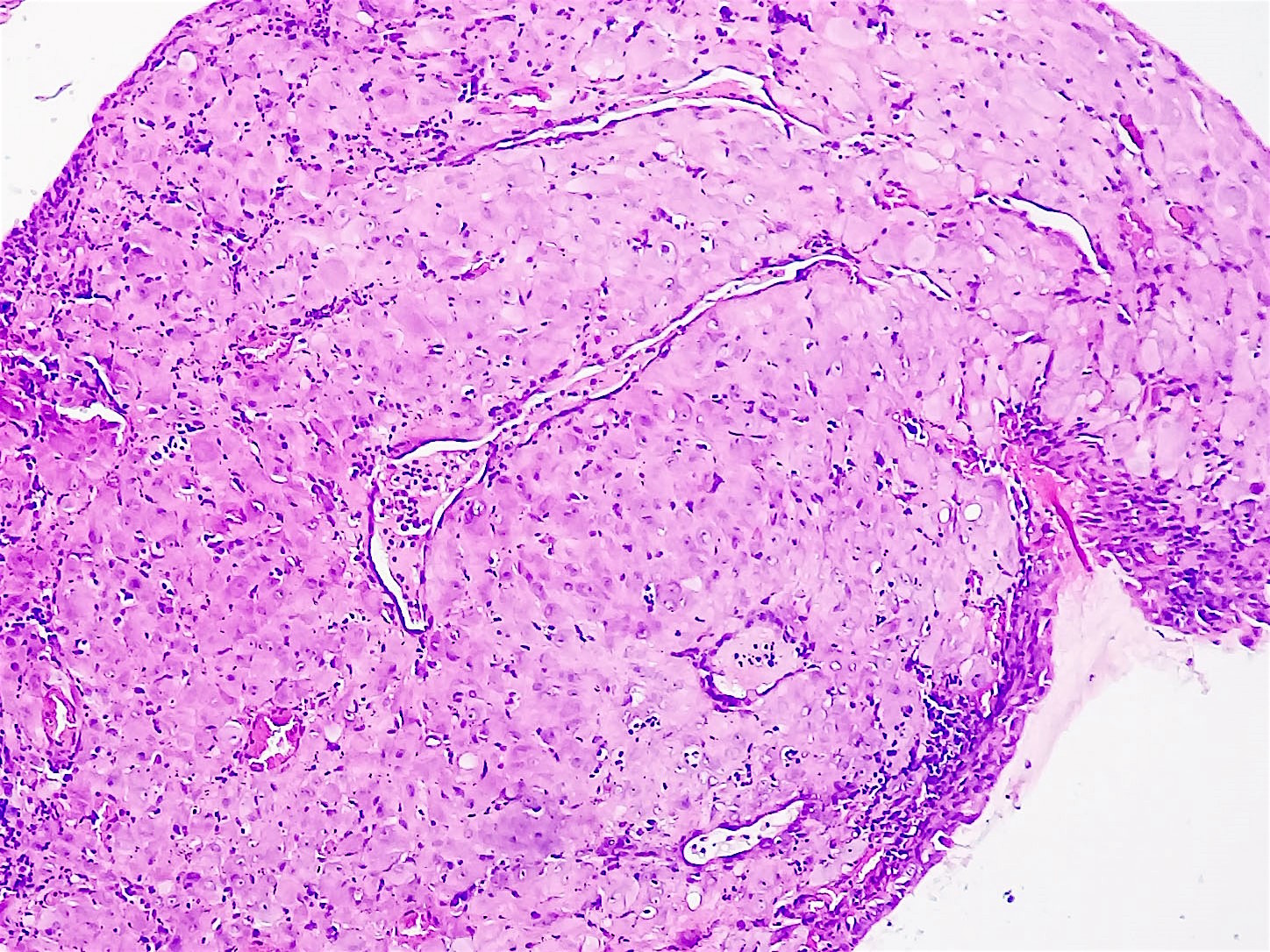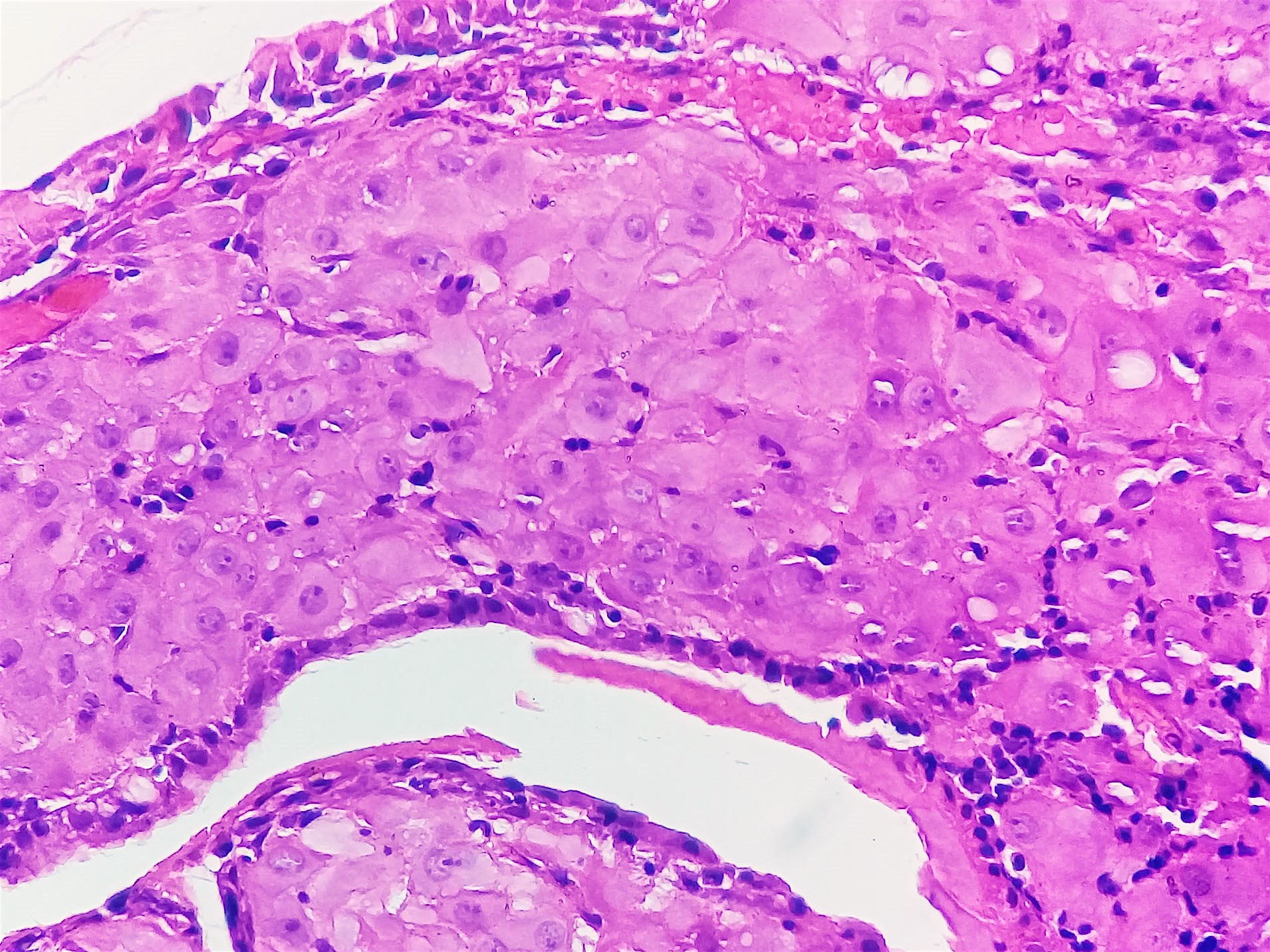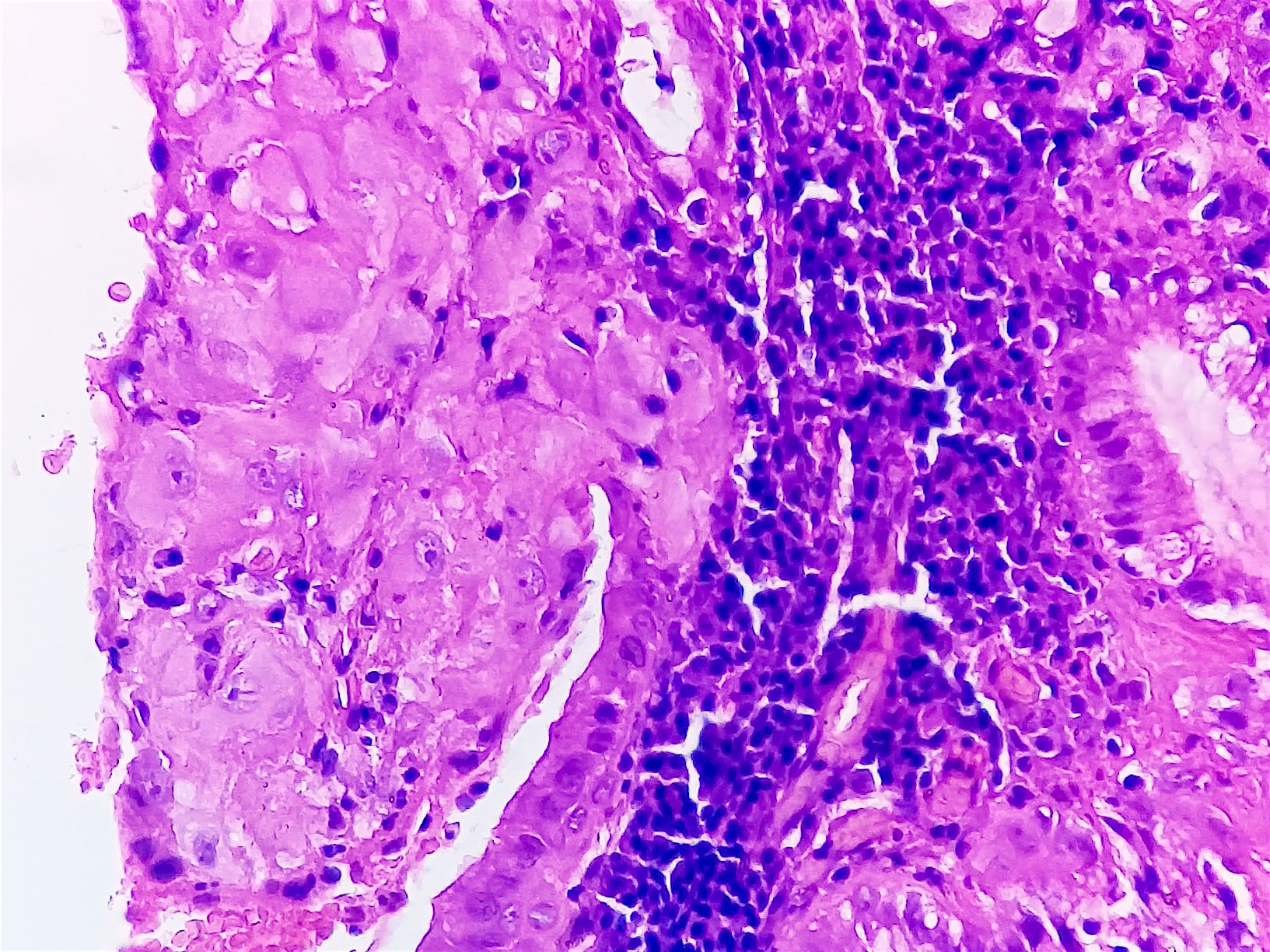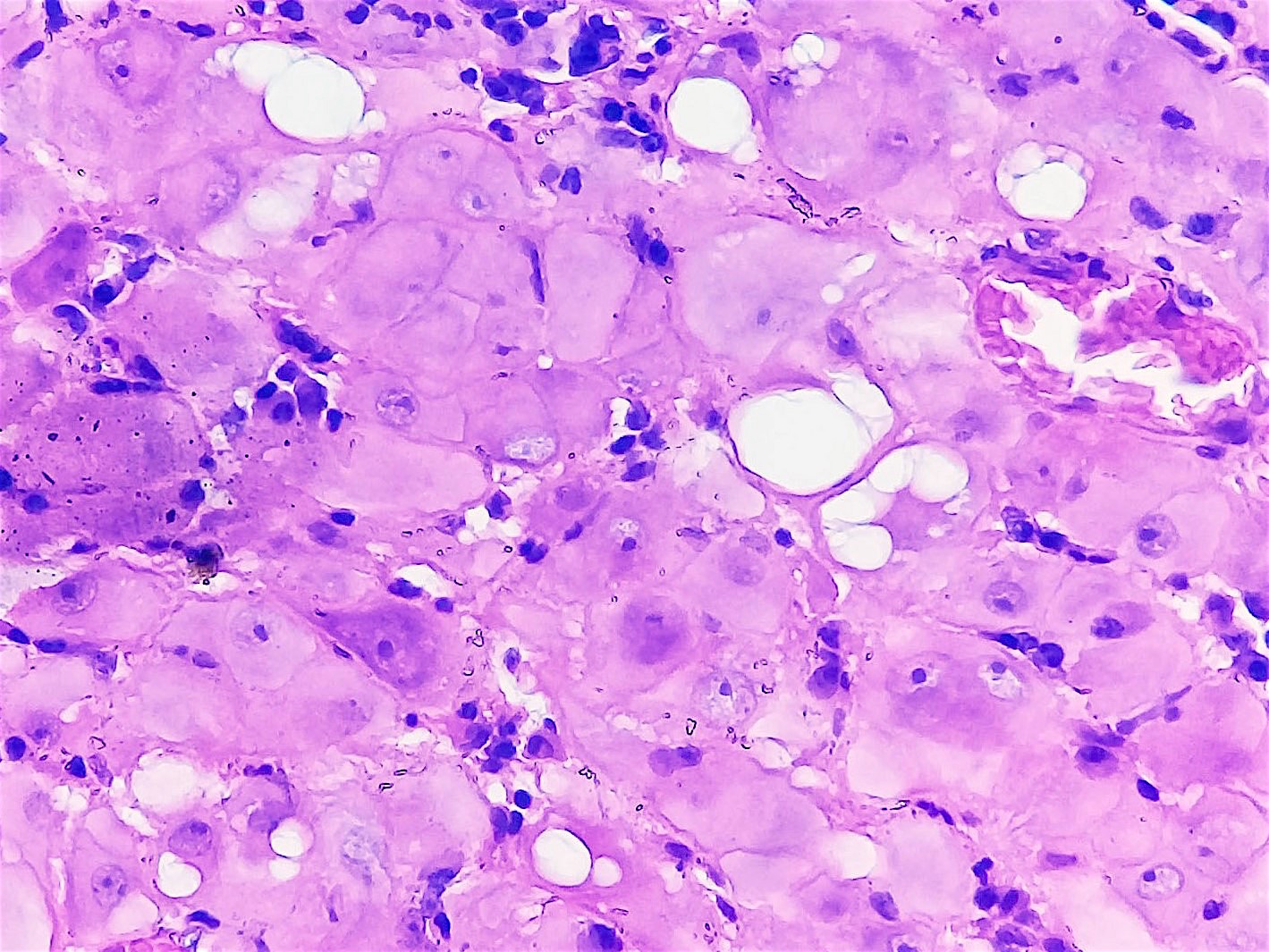Table of Contents
Definition / general | Essential features | Terminology | ICD coding | Epidemiology | Sites | Pathophysiology | Clinical features | Diagnosis | Case reports | Treatment | Microscopic (histologic) description | Microscopic (histologic) images | Cytology description | Positive stains | Negative stains | Sample pathology report | Differential diagnosis | Board review style question #1 | Board review style answer #1 | Board review style question #2 | Board review style answer #2Cite this page: Rosa M. Decidual reaction. PathologyOutlines.com website. https://www.pathologyoutlines.com/topic/cervixdecidual.html. Accessed April 24th, 2024.
Definition / general
- Refers to a progesterone mediated transitory change of the stromal cells on the cervix during pregnancy
- Regresses a few weeks after delivery
Essential features
- Decidual reaction of the cervix is the presence of ectopic decidual tissue outside the uterine cavity
- Occurs during pregnancy and regresses a few weeks after delivery
- May cause pregnancy complications, such as bleeding
Terminology
- Also known as cervical deciduosis and cervicitis decidualis
- The term deciduum refers to tissues that are shed at birth
- References: BMJ Case Rep 2022;15:e245569, J Low Genit Tract Dis 2005;9:52
ICD coding
- ICD-10: N88.8 - noninflammatory disorders of cervix uteri
Epidemiology
- Seen during pregnancy
- Can be seen in 33% of cervical biopsies from pregnant women
- Can occur in women taking exogenous progesterone therapy
- Reference: BMJ Case Rep 2022;15:e245569
Sites
- Cervix
- Deciduosis may occur in other organs and in the peritoneal cavity (see Ectopic decidual reaction)
- References: BMJ Case Rep 2022;15:e245569, Turk Patoloji Derg 2012;28:56, Gynecol Obstet Fertil 2012;40:235
Pathophysiology
- Driver of decidualization is the hormone progesterone
- Progesterone is produced by the corpus luteum during the last half of the menstrual cycle
- If pregnancy occurs, the corpus luteum maintains the production of progesterone until the placenta is developed
- Biochemical factors, such as lipid mediators, prostaglandins, interleukins and glucose, among others, also promote and support decidualization during pregnancy
- References: Int J Mol Sci 2020;21:4092, BMJ Case Rep 2022;15:e245569
Clinical features
- Usually asymptomatic
- Can cause bleeding
- Lesions may be confused with cervical polyps, cervical dysplasia or malignant growth
- Resolves spontaneously within 4 to 6 weeks postpartum
- References: J Low Genit Tract Dis 2005;9:52, BMJ Case Rep 2022;15:e245569, BMJ Case Rep 2015;2015:bcr2015210030
Diagnosis
- Usually an incidental finding
- Clinical speculum examination
- Ultrasound
- Reference: Eurasian J Med 2021;53:152
Case reports
- 28 year old woman at 24 weeks gestation with excessive vaginal bleeding (Eurasian J Med 2021;53:152)
- 34 year old woman, gravida 2 para 0, with vaginal blood loss and cervical lesions (BMJ Case Rep 2015;2015:bcr2015210030)
- 35 year old pregnant woman with growing nodule on cervix (Case #480)
- 36 year old Caucasian woman presented to the emergency room at 32 weeks gestation with acute lower abdominal pain, mild fever and nausea (Case Rep Obstet Gynecol 2020;2020:8847082)
Treatment
- Treatment varies according to presentation
- If asymptomatic, no treatment is required
Microscopic (histologic) description
- Decidual change is characterized by large, rounded cells with abundant pale eosinophilic cytoplasm, large bland nuclei with prominent nucleoli
Microscopic (histologic) images
Cytology description
- Cells occur in aggregates or singly, have abundant cytoplasm, marked nuclear enlargement with finely granular chromatin and prominent nucleoli
- Cell size is similar to mature squamous cells
Positive stains
- Immunostains are usually not necessary to make this diagnosis
- Positive stains are vimentin, desmin, alpha-1 antitrypsin
- Variable staining is seen with PLAP, beta hCG
- References: BMJ Case Rep 2014;2014:bcr2013202480, Case Rep Obstet Gynecol 2020;2020:8847082
Negative stains
Sample pathology report
- Cervix, biopsy:
- Benign squamous mucosa with stromal decidual changes
Differential diagnosis
- Squamous cell carcinoma:
- Decidual cells are large and eosinophilic; however, no cytologic atypia or necrosis is present
- Clinical presentation and history of pregnancy are key
- Metastatic disease:
- If decidualization is present in other organs, it may mimic metastatic carcinoma
- Absence of malignant or atypical features as well as the clinical history are key to the diagnosis
Board review style question #1
Which of the following is true about cervical deciduosis?
- Cervical deciduosis is a dysplastic change in the cervix
- Cervical deciduosis is a diagnosis of exclusion
- Deciduosis has only been reported in organs of the gynecological tract
- Gross examination allows a straightforward assessment of cervical deciduosis versus other entities in the cervix
- True incidence of cervical deciduosis is unknown but it is thought to be common during pregnancy
Board review style answer #1
E. True incidence of cervical deciduosis is unknown but it is thought to be common during pregnancy. Since cervical deciduosis is often detected incidentally and is usually asymptomatic, the true incidence is unknown; however, studies have shown the incidence may be as high as 34% of pregnancies.
Comment Here
Reference: Decidual reaction
Comment Here
Reference: Decidual reaction
Board review style question #2
Which statement is true regarding decidual changes during pregnancy?
- Before treatment, tissue biopsy is necessary to confirm the diagnosis
- Cervical deciduosis usually resolves spontaneously within 4 to 6 weeks postpartum
- Decidual changes are confined to the epithelial cells of the cervix and the endometrium
- Decidual changes can involve the cervix and the breast lactiferous ducts
- Treatment includes cryotherapy or excision
Board review style answer #2
B. Cervical deciduosis occurs during pregnancy and self resolves usually within 4 to 6 weeks postpartum. Treatment is not required. Decidual changes have not been described in breast tissue.
Comment Here
Reference: Decidual reaction
Comment Here
Reference: Decidual reaction








